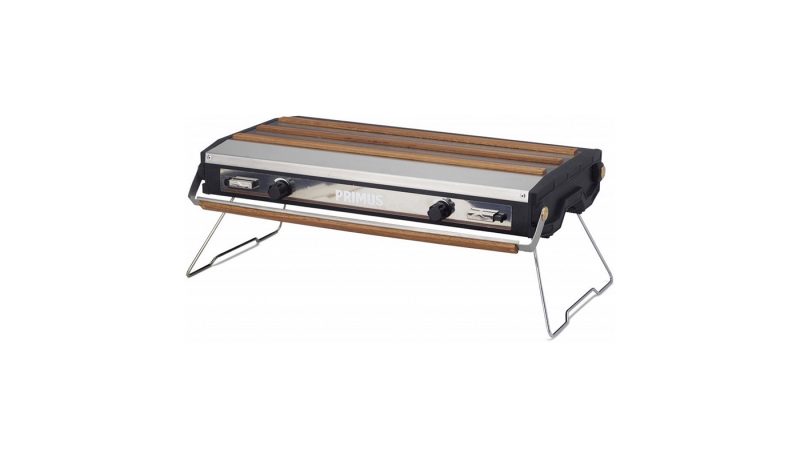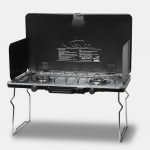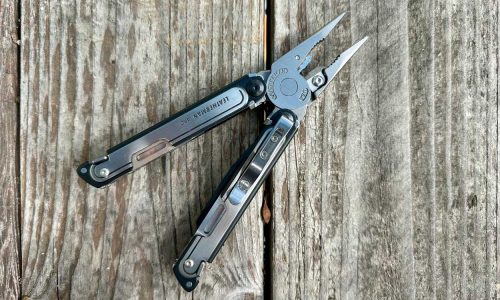Home » Gear Reviews » Hiking & Camping » Camping Stoves » Car Camping Stoves » Primus Tupike
Primus Tupike Review
April 22, 2018



















 84
84 The Good
- Appearance
- Simmer
- Ease of use
- Multi-fuel use
- Locking carry handle
The Bad
- Wind performance
- Igniters
- Price
- Low BTUs
Cooking
The Tupike’s power didn’t stand out among its test competitors, and is in fact the least powerful per burner stove in the test. However, its 7,000 BTU burners and valve-embedded regulator mean it is the most controllable cooker in the group, offering a superb simmer and a wide range of control. For example, testing showed the regulated simmer of the Tupike was able to keep a Chemex pot of coffee balanced at the ideal temperature. Unfortunately, the lack of wind resistance hampers overall performance. The side windscreens are small, have no mechanism for staying in place when deployed, and therefore are more annoying than functional, an odd design choice given Primus’ heritage in this space.
The Tupike was used to cook typical camping fare, such as sausages, eggs, chili, pastas, and hamburgers. When conditions allowed, it did its job admirably. The included skillet is nice in theory but too small for any sort of group-size ingredients; seared vegetables and a couple of chicken sausages landed in the drip pan a time or two. I don’t recommended cooking bacon on it, either. Grease accumulated quickly, crested the rim, and permanently scarred the drip pan.
Durability
A couple of minor issues appeared throughout testing but otherwise the stainless steel and diecast aluminum Primus Tupike held up nicely while being packed, cramped, unfolded, and turned-on dozens of times. One of the two built-in ignitors faltered, not rare for a piezo. Initial worries about its toughness stemmed from the lid-locking mechanism controlled by swiveling the Tupike’s handle from horizontal to vertical during transport. The design is simple: two semi-circular plastic gaskets embedded at each end of the handle fit over a brass-capped screw on the stove body when the lid is closed. Rotating the handle down 90º locks the gaskets over the brass caps. I found no flaws during testing. Still, a couple of years of frequent use or an awkward drop could prove otherwise, which led to the Tupike being branded best of test for Seasonal Campers.
The cosmetic, oak lathes remained firmly attached, ensuring the Tupike will always vie to be the best looking stove in the campground. The hinges on the thin folding supports remained functional throughout testing despite a narrow footprint, and the rear hinges stayed tight but smooth. A small elastic band that holds the fuel line and valve tucked in a storage enclave beneath the stove snapped. This is meaningless from a performance perspective, but annoying not to have when packing the stove.
Portability
The Tupike closes securely and carries comfortably. Its legs fold inward and over an internal housing designed to nest the fuel regulator.
Still, issues linger as a result of its cosmetics, as the oak strips screwed to the aluminum “plateaued” lid encouraged me to handle it less vigorously than I would its competitors. Their intent may be added protection, but the result is gentle handling. Who wants to place a cooler or heavy duffel on something that looks this good?
The removable, minimalist steel cooking grate is flipped over to allow for lid closure. The locking handle design does give one confidence that the lid will remain in place throughout transit, and it’s easy to carry with one hand. Verified at 9 pounds 4 ounces, the Tupike is heavier than the Jetboil Genesis, making it light enough for campers of all ages. The Tupike’s dimensions were verified at 3.2″ high when closed, and 18.7″ wide x 11.6″ deep.
Features
The Primus Tupike is a very elegant camping product. The sturdy diecast housing, brass accents, and oak handle and lathes are its highlights, making its look and feel as much of a feature as its locking carry handle.
My test sample was missing a part that allowed for the stove’s use with isobutane canisters, but its multi-fuel accessibility is an attractive selling point. Two front-mounted piezo igniters are partnered with burly, notched fuel control dials that aren’t quite suitable for use with mittens, but easy to handle with winter gloves. The flexible fuel line is stowed under the stove body, able to position fuel canisters comfortably away from the flame. The one-piece grill grate is heavy coated steel, with two X-shaped pot supports welded to horizontal beams that nest via small pillars into machined holes on the removable aluminum drip tray. It’s an effective, simple design. A small griddle plate comes with the Tupike, complete with folding handle and a storage bag that also houses a multi-tool for swapping out fuel valves. Although the folding legs provide a wide stance and are coated for grip on the bottom, they offer reason to be concerned about stability, especially if using the extra table space under the raised Tupike for utensils and condiments.
Setup & Use
The Primus Tupike is easy to set-up, easy to cook with, and should require little ongoing maintenance. Set up is simple, requiring users to unfold the legs, free the regulator from its storage nook, and rotate the handle vertically to unlock and open the lid. An instructional decal illustrates handle modes.
The valve/regulator combo comes ready for use with standard green 16 ounce propane bottles. An included multi-tool is needed to swap out fuel valves when switching to isobutane canisters. It’s easy to do with only a few twists of a nut tool, but my sample was missing a rubber washer to complete the swap. The front-mounted control knobs and push-button igniters start and control fuel flow to the burners, no additional interaction with the regulator is needed to open or close the fuel source, a function still common on products in this category. The hinged wind guards are slightly magnetized to stick to the inside of the lid when stowed, but without a proper way to be held in position after deployment, I found them swinging back above the burner or resting against hot pots and pans.
Guide, writer, Truckee local, pub trivia host, and inventor of TripTarp®, Craig Rowe is the Gear Institute's chief stove and insulated jacket tester.




















No reviews have been posted for this product.
Use this gear?
Join Gear Nation and leave a review!
Create an Account